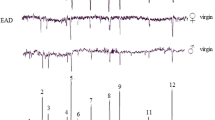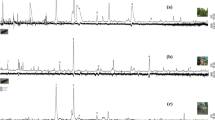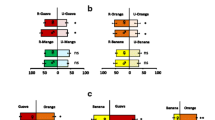Abstract
Plant volatiles play a key role in host plant location of phytophagous insects. Cydia molesta is an important pest of pear fruit late in the growing season. We identified and quantified volatiles from immature and mature fruits of six pear varieties by using gas chromatography–mass spectrometry (GC-MS). Attractiveness of synthetic blends to adults based on gas chromatography-electroantennogram detection (GC-EAD) activity was investigated in both field and laboratory. Consistent electroantennographic activity was obtained for 12 compounds from headspace collections of the mature fruits of the six pear varieties. Qualitative and quantitative differences were found among six odor profiles. Among the six mixtures, the mixture of 1-hexanol, nonanal, ethyl butanoate, butyl acetate, ethyl hexanoate, hexyl acetate, hexyl butanoate, and farnesene (different isomers) with a 1:1:100:70:7:5:1:4 ratio from the variety Jimi and the mixture of nonanal, ethyl butanoate, 3-methylbutyl acetate, ethyl hexanoate, hexyl acetate, and farnesene with a 1:100:1:32:1:2 ratio from the variety Huangjin were highly attractive to both sexes in the field. However, male captures were much higher than those of females. Further wind tunnel tests proved that both sexes exhibited upwind flight to the lures, but only males landed on the source. Our finding indicates that mixtures mimicking Jimi and Huangjin volatiles attract both females and males of C. molesta, and these host volatiles may be involved in mate finding behavior.





Similar content being viewed by others
References
Anfora, G., Tasin, M., Cristofaro, A. D., Ioriatti, C., and Lucchi, A. 2009. Synthetic grape volatiles attract mated Lobesia botrana females in laboratory and field bioassays. J. Chem. Ecol. 35:1054–1062.
Angioy, A. M., Desogus, A., Barbarossa, I. T., anderson, P., and Hansson, B. S. 2003. Extreme sensitivity in an olfactory system. Chem. Senses 28:279–284.
Ansebo, L., Coracini, M. D. A., Bengtsson, M., Liblikas, I., Ramirez, M., Borg Karlsson, A.-K., Tasin, M., and Witzgall, P. 2004. Antennal and behavioural response of codling moth Cydia pomonella to plant volatiles. J. Appl. Entomol. 128:488–493.
Bäckman, A. C., anderson, P., Bengtsson, M., Löfqvist, J., Unelius, C. R., and Witzgall, P. 2000. Antennal response of codling moth males, Cydia pomonella L. (Lepidoptera: Tortricidae), to the geometric isomers of codlemone and codlemone acetate. J. Comp. Physiol. A 186:513–519.
Bruce, T. J. A., Wadhams, L. J., and Woodcock, C. M. 2005. Insect host location: a volatile situation. Trends Plant Sci. 10:269–274.
Bruce, T. J. A., Martin, J. L., Smart, L. E., and Pickett, J. A. 2011. Development of semiochemical attractants for monitoring bean seed beetle, Bruchus rufimanus. Pest Manag. Sci. 67:1303–1308.
Buttery, R. G., Kamm, J. A., and Ling, L. C. 1984. Volatile components of red clover leaves, flowers, and seed pods: possible insect attractants. J. Agric. Food Chem. 32:254–256.
Cao, Y. F., Li, S. L., Huang, L. S., Sun, B. J., and Tan, X. W. 2000. Comprehensive evaluation of pear variety resource in China. China Fruit 4:42–44.
Cao, Y. F., Liu, F. Z., Hu, H. J., and Zhang, B. B. 2006. Descriptors and Data Standard for Pear (Pyrus spp.). China Agric Press, Beijing.
Casado, D., Gemeno, C., Avilla, J., and Riba, M. 2008. Diurnal variation of walnut tree volatiles and electrophysiological responses in Cydia pomonella (Lepidoptera: Tortricidae). Pest Manag. Sci. 64:736–747.
Cha, D. H., Nojima, S., Hesler, S. P., Zhang, A. J., Linn Jr., C. E., Roelofs, W. L., and LOEB, G. M. 2008. Identification and field evaluation of grape shoot volatiles attractive to female grape berry moth (Paralobesia viteana). J. Chem. Ecol. 34:1180–1189.
Clark, L. G. and Dennehy, T. J. 2002. Oviposition behaviour of grape berry moth. Entomol. Exp. Appl. 47:223–230.
Coracini, M., Bengtsson, M., Liblikas, L., and Witzgall, P. 2004. Attraction of coding moth males to apple volatiles. Entomol. Exp. Appl. 110:1–10.
Dorn, S., Hughes, J., Molinari, F., and Cravedi, P. 2001. Cydia molesta and Cydia pomonella: comparison of adult behaviour. IOBC wprs Bull. 24:133–137.
Fraenkel, G. S. 1959. The raison d’être of secondary plant substances. Science 129:1466–1470.
Hilker, M. and McNEIL, J. 2008. Chemical and behavioral ecology in insect parasitoids: how to behave optimally in a complex odourous environment, pp. 92–112, in E. Wajnberg, C. Bernstein, and J. van Alphen (eds.), Behavioral Ecology of Insect Parasitoids. Blackwell, Malden.
Hughes, J. and Dorn, S. 2002. Sexual differences in the flight performance of the oriental fruit moth, Cydia molesta. Entomol. Exp. Appl. 103:171–182.
Il’ichev, A. L., Kugimiya, S., Williams, D. G., and Takabayashi, J. 2009. Volatile compounds from young peach shoots attract males of oriental fruit moth in the field. J. Plant Interact. 4:289–294.
Jiang, W. B., Gao, G. L., Yu, K. J., and Ma, K. 2002. Creation of pear variety resource in China over the past decade and its prospects. J. Fruit Sci. 19:314–320.
Kovanci, O. B., Gencer, N. S., and Larsen, T. E. 2009. The deposition and retention of a microencapsulated oriental fruit moth pheromone applied as an ultra-low volume spray in the canopy of three peach cultivars. Bull. Insectol. 62:69–74.
Makaji, T. 1987. Diagnosis of Fruit Tree Diseases and Pests with Color Plates. Agriculture Publication Incorporation, Tokyo.
Mitchell, V. J., Manning, L. A., Cole, L., Suckling, D. M., and El-Sayed, A. M. 2008. Efficacy of the pear ester as a monitoring tool for codling moth Cydia pomonella (Lepidoptera: Tortricidae) in New Zealand apple orchards. Pest Manag. Sci. 64:209–214.
Myers, C. T., Hull, L. A., and Krawczy, K. G. 2006. Effects of orchard host plants on preference of the oriental fruit moth (Lepidoptera: Tortricidae). J. Econ. Entomol. 99:1176–1183.
Natale, D., Mattiacci, L., Hern, A., Pasqualini, E., and Dorn, S. 2003. Response of female Cydia molesta (Lepidoptera: Tortricidae) to plant derived volatiles. Bull. Entomol. Res. 93:335–342.
Natale, D., Mattiacci, L., Pasqualini, E., and Dorn, S. 2004. Apple and peach fruit volatiles and the apple constituent butyl hexanoate attract female oriental fruit moth, Cydia molesta, in the laboratory. J. Appl. Entomol. 128:335–342.
Piñero, J. C. and Dorn, S. 2007. Synergism between aromatic compounds and green leaf volatiles derived from the host plant underlies female attraction in the oriental fruit moth. Entomol. Exp. Appl. 125:185–194.
Piñero, J. C. and Dorn, S. 2009. Response of female oriental fruit moth to volatiles from apple and peach trees at three phenological stages. Entomol. Exp. Appl. 131:67–74.
Piñero, J. C., Galizia, C. G., and Dorn, S. 2008. Synergistic behavioral responses of female oriental fruit moths (Lepidoptera: Tortricidae) to synthetic host plant-derived mixtures are mirrored by odor-evoked calcium activity in their antennal lobes. J. Insect Physiol. 54:333–343.
Reddy, G. V. and Guerrero, A. 2000. Behavioral responses of the diamondback moth, Plutella xylostella, to green leaf volatiles of Brassica oleracea subsp. capitata. J. Agric. Food Chem. 48:6025–6029.
Roehrich, R. 1961. Contribution a l’étude écologique des populations de la tordeuse de pêcher (Grapholita molesta Busck) dans la région Aquitaine. Annales de l’Institut National de la Recherche Agronomique, Paris.
Roelofs, W. L., Comeau, A., and Selle, R. 1969. Sex pheromone of the oriental fruit moth. Nature 224:723.
Rothschild, G. H. L. and Vickers, R. A. 1991. Biology, ecology and control of the oriental fruit moth, pp. 389–412, in L. P. S. Van der Geest and H. H. Evenhuis (eds.), Tortricid Pests: Their Biology. Natural Enemies and Control. Elsevier, Amsterdam.
Steiner, L. F. and Yetter, W. P. 1933. Second report on the efficiency of bait traps for the oriental fruit moth as indicated by the release and capture of marked moths. J. Econ. Entomol. 26:774–788.
Stelinski, L. L., Gut, L. J., Mallinger, R. E., Epstein, D., Reed, T. P., and Miller, J. R. 2005. Small plot trials documenting effective mating disruption of oriental fruit moth by using high densities of wax-drop pheromone dispensers. J. Econ. Entomol. 98:1267–1274.
Szafranek, B., Chrapkowska, K., Waligora, D., Palavinskas, R., Banach, A., and Szafranek, J. 2006. Leaf surface sesquiterpene alcohols of the potato (Solanum tuberosum) and their influence on Colorado beetle (Leptinotarsa decemlineata Say) feeding. J. Agric. Food Chem. 54:7729–7734.
Tasin, M., Anfora, G., Ioriatti, C., Carlin, S., and de Cristofaro, A. 2005. Antennal and behavioral responses of grapevine moth Lobesia botrana females to volatiles from grapevine. J. Chem. Ecol. 31:77–87.
Tasin, M., Bäckman, A. C., Coracini, M., Casado, D., Ioriatti, C., and Witzgall, P. 2007. Synergism and redundancy in a plant volatile blend attracting grapevine moth females. Phytochemistry 68:203–209.
Tasin, M., Bäckman, A. C., Anfora, G., Carlin, S., Ioriatti, C., and Witzgall, P. 2009. Attraction of female grapevine moth to common and specific olfactory cues from 2 host plants. Chem. Senses 35:57–64.
Trimble, R. M., Pree, D. J., Barszcz, E. S., and Carter, N. J. 2004. Comparison of a sprayable pheromone formulation and two hand-applied pheromone dispensers for use in the integrated control of oriental fruit moth (Lepidoptera: Tortricidae). J. Econ. Entomol. 97:482–489.
Visser, J. H. and Avé, D. A. 1978. General green leaf volatiles in the olfactory orientation of the Colorado beetle, Leptinotarsa decemlineata. Entomol. Exp. Appl. 24:738–749.
Wildbolz, T. 1958. Uber die Orientierung des Apfelwicklers bei der Eiablage. Mitt. Schweiz. Entomol. Ges. 31:25–34.
Witzgall, P., Bäckman, A. C., Svensson, M., Koch, U. T., Rama, F., El-Sayed, A., Brauchli, J., Arn, H., Bengtsson, M., and Löfqvist, J. 1999. Behavioral observations of codling moth, Cydia pomonella, in orchards permeated with synthetic pheromone. Biocontrol 44:211–237.
Yang, X. Y. and Liu, J. L. 2010. The reason of serious damage of Grapholitha molesta in 2008. Shanxi Fruit 1:38.
Yang, C. Y., Jung, J. K., Han, K. S., Boo, K. S., and Yiem, M. S. 2002. Sex pheromone composition and monitoring of the oriental fruit moth, Grapholitha molesta (Lepidoptera: Tortricidae) in Naju pear orchards. J. Asia Pac. Entomol. 5:201–207.
Yetter, W. P. and Steiner, L. F. 1932. Efficiency of bait traps for the oriental fruit moth as indicated by the release and capture of marked adults. J. Econ. Entomol. 25:106–116.
Zhang, Q. H., Ma, J. H., Yang, Q. Q., Byers, J. A., Klein, M. G., Zhao, F. Y., and Luo, Y. Q. 2011. Olfactory and visual responses of the long-legged chafer Hoplia spectabilis Medvedev (Coleoptera: Scarabaeidae) in Qinghai Province, China. Pest Manag. Sci. 67:162–169.
Zhao, Z. R., Wang, Y. G., and Yan, G. Y. 1989. The report of primary study on Grapholitha molesta in north of Jiangshu Province. Entomol. Knowl. 26:17–19.
Acknowledgments
We thank Rui Wang and Xiao-Wei Qin in our laboratory for technical assistance in GC-EAD and GC-MS, and Jun Liu from the Institute of Forestry and Pomology, Beijing Academy of Agriculture and Forestry Sciences for supplying facilities for field trials. We also thank Paolo Pelosi, University of Pisa, and Joop van Loon, Wageningen University, for help in improving the paper, and three anonymous reviewers for critical comments and suggestions. This work was supported by Public Welfare Project from Ministry of Agriculture of China (grant no. 200803006) and projects of Postdoctoral Science Foundation (grant no. 201104140) and the National Natural Science Foundation of China (grant no. 30925026, 30621003).
Author information
Authors and Affiliations
Corresponding author
Rights and permissions
About this article
Cite this article
Lu, PF., Huang, LQ. & Wang, CZ. Identification and Field Evaluation of Pear Fruit Volatiles Attractive to the Oriental Fruit Moth, Cydia molesta . J Chem Ecol 38, 1003–1016 (2012). https://doi.org/10.1007/s10886-012-0152-4
Received:
Revised:
Accepted:
Published:
Issue Date:
DOI: https://doi.org/10.1007/s10886-012-0152-4




